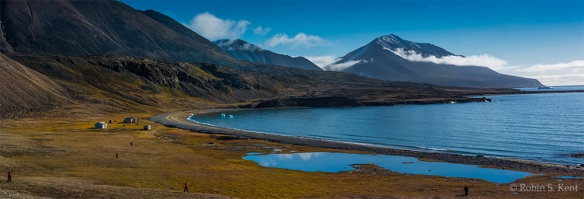After departing Greenland, we sailed across Baffin Bay during the night heading toward Lancaster Sound. By the early 19th century, two hundred years after the ice-choked Sound had blocked the Bylot and Baffin expedition (see previous post), every effort to penetrate its waters had ended in failure.

Sunrise, Baffin Bay, Approaching Lancaster Sound (4:08 AM)
But finally, in August 1819, Edward Parry led an expedition into Barrow Strait, the eastern entrance to the Arctic Archipelago and reached a point beyond Lancaster Sound that would turn out to be the half-way point of the Northwest Passage. The onset of the sea ice blocked further progress, however, and they overwintered on Melville Island. In February, they made an overland trek westward some 80 miles or more to find a location where the sea resumed. Even so, the spot was so thick with sea ice it required digging down more than 14 feet before reaching sea water. It immediately flowed up almost to the surface of the ice convincing them they were right. Six months later, their ships trapped at Melville Island were able to break free of their ice and Parry sailed home to a hero’s welcome. He had gone far further than any European but the Northwest Passage remained unconquered.
Our goals today were far more modest and, unmolested by any pesky sea ice, we entered Dundas Harbor on Devon Island at the eastern entrance to Lancaster Sound. We had reached the Canadian Arctic Archipelago.

Approaching Dundas Harbor, Devon Island (9:28 AM)
The skies were now clear, but a low hanging fog provided a mysterious quality to the planned landing area for the Zodiacs. As we neared the island, the sun and fog combined to create a stunning example of a “fog bow.”

“Fog Bow,” Duindas Harbor
This phenomenon is similar to a rainbow, except the much smaller water particles of fog make it (according to a lengthy technical description) virtually impossible to see the colors that characterize a rainbow.
When the fog cleared, Zodiacs carried us to the shore and a nice hike over a hill to the site of an abandoned post of the Royal Canadian Mounted Police.

Abandoned RCMP Post, Devon Island
From the crest of the hill, one can imagine why this spot might have been selected back in the 1920s as an outpost for Canada to assert its sovereignty over its northern territory. However, the easy weather of August (actually above freezing when this image was made) is deceiving. Over the following decades it was sporadically abandoned on several occasions, no occupation lasting more than a few years. It was last occupied in 1951, and the buildings are slowly deteriorating. Two grave sites of individuals who had been assigned there served as a grim foreshadowing of what we would encounter tomorrow.

Robin, thanks so much for sharing there fantastic images and narrative
LikeLike
Thanks, John. I appreciate your commenting. It was a very cool experience; I’m still going through the images.
LikeLike
I can’t wait for tomorrow!
LikeLiked by 1 person
Thanks, Michele! Hope to have it out soon, but first I have a few more prints to run off;-)
LikeLike
Great post Robin, really enjoying this series!
LikeLiked by 1 person
Thanks, Chris! Stay tuned for our encounter with s/v Vagabond.
LikeLike
Wow. this is stunning
LikeLike
Thanks so much Rajiv!
LikeLiked by 1 person
I’m really enjoying your trip. What an amazing adventure!
LikeLiked by 1 person
Thanks, Laura. It really was, seemed like we had something unexpected happen each day.
LikeLiked by 1 person
Wonderful.
LikeLiked by 1 person
Thanks!
LikeLike
What an amazing adventure.
LikeLiked by 1 person
Thanks for your comments, it’s always great to hear from you.
LikeLike
The last picture especially shows the pristine environment; the air and water look so crisp and clear.
LikeLike